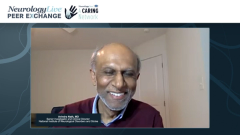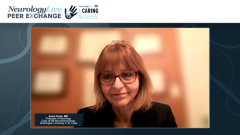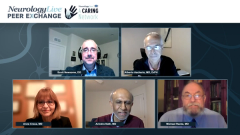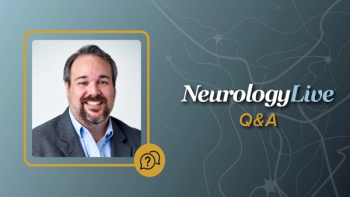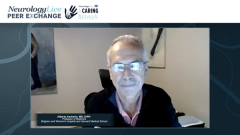
Examining Immune Response to Epstein-Barr Virus
A panel of experts probe the variations in immune response to Epstein-Barr virus in patients with multiple sclerosis.
Episodes in this series

Scott Newsome, DO: Anne, I see on your face that you want to ask a question. You’re all allowed to ask questions. I don’t have to be the only person asking questions.
Anne Cross, MD: This is a burning question. Alberto, in 1 of your earlier papers you showed that the risk was particularly higher in persons who got Epstein-Barr virus [EBV] or at least a symptomatic mononucleosis when they were a little older, maybe in their teens or so. It seems like in this study, these persons who were developing an Epstein-Barr virus infection were in their teens or slightly older. Do you think the age of getting it is meaningful?
Alberto Ascherio, MD, DrPH: The data are about the history of mononucleosis. We don’t know the age of infection for people who are symptomatic except in our study. The previous literature showed that history of mononucleosis is associated with a 2.3-fold increased risk of MS [multiple sclerosis]. I’m being precise on the 2.3 because there have been several meta-analyses, and it’s remarkably consistent. It’s a strong risk factor, but this is more for Mike or Avi to comment on the possibility that the immune response to EBV when you get mononucleosis is bigger than in people who have a symptomatic EBV infection. I don’t think we fully understand the mechanism behind this association in this case between mononucleosis and MS risk.
Scott Newsome, DO: That’s interesting. Avi, I don’t know if you want to comment on whether someone is symptomatic or asymptomatic. This could be with any virus exposure. I’m sure we’re going to learn with COVID-19 also about the long-hauler situation in those who are asymptomatic vs symptomatic or mild vs severe. That’s curious.
Avindra Nath, MD: There are 2 things. First, with any infection, as Alberto was saying, you get different types of clinical presentations. Let’s say the flu runs through your family. You’ll find 1 family member who gets really sick, another who has relatively mild symptoms, and someone who’s asymptomatic. It’s the same family with different types of presentations. Your workplace is the same thing. If somebody comes in infected and infects everybody, some fall sick and some don’t. There’s a host response to infections that’s different. Maybe the host genetics or host factors might dictate the response that people get. Is that relevant for multiple sclerosis?
Alberto is trying to make the case that if you’re older and have a very strong immune reaction, maybe that’s contributing to the pathophysiology. If that’s the case, you might see what’s called epitope spreading. Particularly if you have persistent infection or a very robust infection, you may get antibodies against multiple epitopes. If it’s persistent over a period of time, you’ll get more epitopes, against which you’ll get an immune response. Alberto, in your peptide library or however you’ve looked at it, have you looked to see what epitopes you get antibodies against? Does that change over a period of time?
Alberto Ascherio, MD, DrPH: Yes, we could look at that. So far, we see that with all the epitopes that are different, the mechanisms of control are coming from EBV. It’s not 1; there are over 40 epitopes that are in peptides, different EBV proteins, maybe not 1 but 2 other EBV proteins. We’re starting to look at the history and evidence of change over time in terms of the epitope spread. Unfortunately, we know when these individuals were infected, but we don’t have the clinical information to differentiate those who were symptomatic or not symptomatic. That’s not being made available to us. It probably exists in some registry, but we couldn’t access that information.
Michael Racke, MD: If I could interject for a second, it sounds to me in some ways it’s a little similar. I don’t know if you saw the paper from Dr Thomas Wisniewski’s group with COVID-19. If you look at people who had severe infections—people who were hospitalized and had encephalopathy—they had dramatically elevated NfL [neurofilament light chain]. Presumably, the NfL is being elevated because there’s an inflammatory response within the central nervous system causing some damage that now allows you to detect the NfL in the peripheral blood. We probably see this in a lot of instances where there’s something happening in the brain. The thing that’s interesting—we were talking about getting into this earlier—is if you take Alberto’s work on vitamin D and take the vitamin D, EBV, and maybe even HHV-6 [human herpesvirus 6], if people have had all 3 of those things, their risk goes even higher. The important fact is what Alberto said, that of all these factors, there are things that can add to it, but maybe this is 1 of the primary factors. Of all the factors we’ve seen, perhaps this is the 1 that carries the most weight.
Transcript Edited for Clarity
Newsletter
Keep your finger on the pulse of neurology—subscribe to NeurologyLive for expert interviews, new data, and breakthrough treatment updates.

